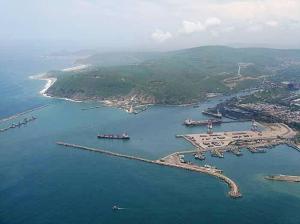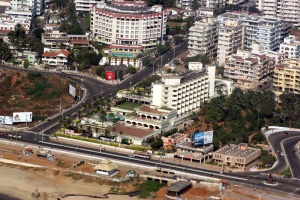ORGANIZING
Organizing refers to the process of bringing together physical, financial and human resources and establishing productive relations among them for the achievement of the specific goals.
William Scott has defined organization as Organizations are collectivities of people that have been established for the pursuit of relatively specific objectives on a more or less on continuous basis.
According to Ralph C. Davis, “Organization is a group or people who cooperate under me direction of leaderships, for the accomplishment of a common end”.
According to Koontz and O’Donnell, “It is the grouping of activities necessary to attain enterprise objectives and the assignment of each grouping to a manner with necessary to supervise it”.
According to G. R. Terry, “Establishing the effective authority relationships among selected works, persons and work-places in order for the group to work together effectively”.
According to A. P Strong, “Organizing is the process of integrating into a coordinated structure of activities required to achieve the objectives of an enterprise; staffing this structure with qualified, competent personnel and supplying them with physical factors necessary to perform their functions”.
According to Theo Haimann, “Organizing is the process of forming and grouping the activities of the enterprise and establishing the authority relationships among them. In performing the organizing functions, the manager defines, departmentalizes and assigns activities so that they can be most effectively executed”.
Principles of Organization :
In an organization if a work is not allocated properly , there may arise conflicts and frictions among the people. So as to develop a sound and efficient organization, there is need to follow certain principles.
Unity of Objectives : It means that every part of the organization and the organization as a whole should be geared to the basic objective determined by the enterprise.
Principle of flexibility : An organization should be flexible so that the changes can be adopt whenever need arise. The organization is based on environment and these environments are not fixed but change over the period of time. So, there is a need for the organization to change according to the environmental change
Span of Management: A manager can directly supervise only a limited number of executives; hence it is necessary to have a proper number of executives answerable to the top manager.
Functional Definition: The duties and authority relationships in a good organization must be properly and clearly defined so that there may be no confusion or over lapping.
Unity of Command: According to this principle each subordinate should have one superior whose command he has to obey. This will avoid conflict of commands and will help in fixing responsibility.
Unity of Direction: There should be only one plan for a group of activities directed toward the same end. If each person in a department begins to work under a different plan or program of action, nothing but confusion will follow.
Scalar Principle (Chain of Command): The chain of command or the line of authority must be clearly defined for building sound organization. Every subordinate must know who is superior and to whom policy matters beyond his own authority must be referred for decision.
Responsibility: In a good organization, the superior is responsible for the activities of his subordinates and the subordinates must be held responsible to their superiors for the performance of the tasks assigned to them.
Balance: Some matters may be left to be disposed off by the subordinates at the lower or the lowest level while some other (say. control over capital expenditure) must be centralized and a balance between centralization and decentralization should thus be achieved.
Specialization: The organization should design in such a way that every individual should be assigned duties according to their skills and abilities. The departments should be created on the basis of specialization.
Coordination: Different means of organization are to be utilized by the different persons of the enterprise in such a coordination manner so that even if they work efficiently, they should not work for cross-purposes.
Continuity: Organization is a continuing process, every now and then there are some changes and in some cases the repetitive activities continue. The organizational framework would be designed in such a manner so that the same line of the organization activities may efficiently continue.
Clear Definition of Authority and Responsibility: The authority and responsibility of each manager should be clearly defined in writing such that he knows what is expected of him and the limits of his authority to get it done. This will help in eliminating any overlapping of authority and gaps between responsibilities. It will also facilitate replacement of a manager.
Flexibility: Flexibility in the organization structure is necessary to enable it to adjust and adapt itself to any change in its environment, for example, conditions of boom, depression, political instability, etc.
Simplicity: The organization structure should be simple, i.e., with as few levels of authority as possible, such that there is free communication between persons operating at different levels, thus making for effective coordination.
Efficiency: The organization should be able to attain the mission and the objectives at the minimum cost, and if it does so, it satisfies the test of efficiency.
Facilitation of Leadership: Organization structure should be so devised that there is enough opportunity for the management to give effective leadership to the enterprise.
Importance of Organization
Increases the Efficiency of Management: There is the maximum utilization of workers’ ability and productive capacity of the material resources under good organization. Good organization avoids confusion, delays and duplication of work.
Ensures Optimum Utilization of Material Resources and Human Efforts: ‘Right man at the right job’ is fundamental to organization. Good organization brings harmony in the efforts of the employees and the working conditions which add to the total productivity of the enterprise.
Helps in the Growth of Enterprise: Good organization contributes to the growth, diversification and expansion of all enterprises. Big and giant enterprises are the direct result of the success of the organizing functions of management.
Places Proportionate Importance to the Various Activities of the Enterprise: Organization divides the entire enterprise activities into departments and sub-departments, each receiving attention according to its importance or role played towards accomplishing the enterprise objective. Money and efforts are spent proportionately to their contribution which means that emphasis is given according to their relative importance.
Facilitates Co-ordination: Functions and activities of the various departments are welded together to accomplish the enterprise goals. Different departments perform their functions in a closely related manner and not as rivals.
Provides Facilities for Training, Testing and Development of Managerial Personnel: By placing the persons in different departments, training can be imparted, as also their abilities tested. This will be followed by their placement to the places to which they are best suited.
Prevents Growth of Intrigues and Corruption: Unsound organization becomes a breeding ground of intrigues and corruption. Good organization develops the morale, honesty, devotion to duty and the feeling of oneness with enterprise,
Consolidates Growth and Expansion: Organizing practices have encouraged the business enterprises to expand their size to an ever-increasing level. With hundreds of employees and extensive ramifications of operations, giant enterprises are the direct outcome of the organizing function of management.
Stimulates Creativity: Sound organization stimulates independent, creative thinking and initiative by providing well-defined areas of work with broad latitude of the development of new and improved ways of doing things.
Adoption of New Technology: The effectiveness of an enterprise is measured by the reaction of staff members to the adopting of a new technology. In the scientific world, there are a lot of innovations and inventions identified in the area of production, distribution and personnel management.
Meaning & Definition of Formal Organization
A formal organization is deliberately designed to achieve some particular objectives. It refers to the structure of well defined-jobs, each bearing a definite measure of authority, responsibility and accountability.
According to Chester I Barnard, “A Formal Organization is a system of consciously coordinated activities or forces of two or more persons.”
Within the formal organization members undertake the assigned duties in cooperation with each other. They interact or communicate among themselves in the course of their work. Gradually, they develop friendly relations and form
Characteristics of Formal Organizations
Characteristics of formal organizations are as follows:
It has Defined Interrelationship: Formal organization is a sort of arrangement which clearly defines mutual relationship. Everybody knows their authority and responsibilities. This clearly shows who will be reporting to whom.
It is Based on Rules and Procedures: It is important to observe all the predetermined rules and procedures in the formal organization. The objectives laid-down under planning are thus achieve^
It is Based on Division of Work: The chief basis of formal organization is the division of work. It is this that connects the efforts of different departments with each other.
Formal organization has its own specific function or functions: A university for example has the main function of promoting education. But it also promotes artistic, literary, athletic and other interests of the members. Thus the formal organization may have its latent as well as manifest functions.
The formal organization has its own norms or rules of social behavior: Certain conduct is appropriate in certain organization. Formal organization lays down procedure to be followed by the members.
Members of an organization have different statuses: Statuses imply division of labor. Organized actions in a formal organization are possibk because of division of labor. It contributes to the efficiency of the organization. Division of labor leads to specialization.
The formal organization creates authority: Where there is no organization there is no authority where there is no authority there is no organization. Authority is one of the most significant criterions of organization.
Bureaucracy refers to the administrative aspect of the formal organization: It refers to the arrangement of the organization designed to carry out its day to day business. It is represented by a hierarchy of officials who are assigned different responsibilities and provided with different statuses and roles.
The formal organization is based on rationality: The rationality of formal organizations has two sources- the predominance of rules that have oeen devised to help achieve definite results and the systematic reliance on knowledge in the operation of the organization. The formal organizations are relatively permanent. Some organizations last for longer time while others perish within a short period f time.
Advantages of Formal Organization
Easy to Fix Accountability: Since the authority and responsibility of all the employees have been already fixed, inefficient employees can easily be apprehended and in this way accountability can be fixed.
No Overlapping of Works: In the formal organization, everything moves in an orderly manner. Therefore, there is no possibility of any work being left out or unnecessarily duplicated.
Unity of Command Possible: It is possible to observe the principles of unity of command in view of the presence of scalar chain of authority.
Easy to Get Goals: Under the formal organization, it is easy to achieve the goals of the organization because there is an optimum use of all the material and human resources,
Stability in Organization: All the people work by observing rules and remain confined within the domain of their authority. This leads to the establishment of good relationship which in turn leads to stability to the organization.
Disadvantages of Formal Organization
Lack of Initiatives: In this organization the employees have to do what they are told to do and they have no opportunity of thinking. Thus, their initiative gets slackened.
Pressure of Officers Autocracy on Employees: Employees are always under pressure because of the autocratic attitude of the officers and a rigorous implementation of rules as a result of which efficiency is reduced.
Delay in Work: Since the work is bound by rules, it causes unnecessary delay.
Mechanization of Relations: By defining interrelationship among different people, they are bound or restricted to take advantage of the knowledge and experience of other persons, even if they desire so.
INFORMAL ORGANIZATION
An informal organization is a system of social relations, which emerges on its own in a natural manner within the formal organization to meet the cultural and social needs of the members of the organization.
An informal organization does not have a clear and well-defined structure because it is a complex network of social relations among members.
An informal organization is a part of formal organization because informal organization originates from and within the formal organization to meet the social and cultural needs of the workers.
An organization is neither totally formal nor totally informal, but a combination of both the aspects. Both the formal and the informal organizations co-exist together. One cannot be separated from the other since both are related to each other. Both the types of organization affect and are affected by each other.
An informal organization is one which is not reliant on a hierarchical structure, typical of large-scale companies. It is not typical for an entire organization to be informal, as this could cause problems, but formal organizations do tend to have informal ones within them.
Informal organizations have very loose structures. People can become members freely and sometimes spontaneously; relationships are undefined and the sharing of responsibility and involvement of members will vary considerably.
Characteristics of an Informal Organization
The characteristics of an informal organization are as follows:
Creations: It emerges on its own in a natural manner as a result of social interactions among people?
Purpose: It emerges to meet the social and cultural needs of the members of the organization.
Structure: It does not have a clear and well-defined structure because it is a complex network of social relations among the members.
Authority: The authority in an informal organization is personal and is given by group members.
Degree of Flexibility: It is more flexible in the sense that standards of behavior are not officially prescribed, but are evolved by mutual consent of group members. Deviation from the mutually agreed behavior is allowed to some extent
Use of Grapevine: It makes more use of informal channels of communication (which are popularly known as ‘Grapevine’). Informal communication is faster than formal communication but the greatest danger is that it may give rise to rumors. Rumors may prove to be detrimental to the interests of the organization.
Chain of Command: It may or may not follow official chain of command.
Leadership: Leaders are chosen voluntarily by the group members. An informal leader may or may not be the superior under whom the group members are working.
Membership: An individual can be a member of more than one group according to his choice. He may be a leader in one group and a follower in another
Functions of the Informal Organization
The informal organization can serve a number of important functions. Such as:
It provides satisfaction of members social needs, and a sense of personal identity and belonging.
- It provides for additional channels of communication – e.g., through the ‘grapevine’ information of importance to particular members is communicated quickly.
- It provides a means of motivation – e.g., through status, social interaction, variety in routine or tedious jobs, and informal methods of work.
- It provides a feeling of stability and security, and through informal ‘norms’ of behavior can exercise form of control over members.
- It provides a means of highlighting deficiencies or weaknesses in the formal organization – e.g., areas of duties or responsibilities not covered in job descriptions or outdated systems and procedures. The informal organization may also be used when formal methods would take too long, or not be appropriate, to deal with an unusual or unforeseen situation.
Advantages of Informal Organization
1) To Employees
- Sense of Belonging: In a formal organization, there is lack of sense of belongingness and personal satisfaction.
- Value for Emotional Problems: In the daily work routine there are many opportunities for tension and frustration.
- Aid on the Job: In case of accidents or illness, members of an informal group help one another.
- Innovation and Originality: By enabling members to modify the job situation more to their liking, the informal organization creates the necessary environment for individual innovation and originality. The individual can experiment with his ideas.
- Important Channel of Communication: News travels quickly via informal groups. They are the clandestine transmitters and receivers of information before it is officially released
- Social Control: Informal group provide all its members a set of norms or guides to correct behavior. Members are expected to conform to those norms
- Check on Authority: Informal groups force the manager to plan and act more carefully than he would otherwise. Informal organization is a check and balance on unlimited use of authority by a manager.
To Management
- Effective Communication: In the absence of any definite course, it is an effective system of communication. Messages can be quickly conveyed from one place to another with the help of this system.
- Fulfills Social Need : In the informal organization, people having similarity of thoughts and ideas form a group of their own. All the people in the group stand by one another in all the organizational or personal matters.
- Fulfills Organizational Objectives: Here there is no pressure of formal organization. In the informal organization, the subordinates put their ideas before the superiors without any fear or hesitation. It helps the superiors to understand their difficulties and immediate solution of the problem is sought-out. Since the problems are easily solved, it becomes easier to achieve the objectives of the organization.
- Less Supervision: Informal group is self-policing. This relieves the management of much of the burden of supervision,
- Aid to Management: The information gives the manager much feedback about employees and their work experience^ thereby increasing his understanding of what he needs to do.
Disadvantages of Informal Organization
Resistance to Change: An informal organization is bound by customs, conventions, and culture.
Role Conflict and Sub-Optimization: In an informal organization, everyone works towards the same objectives.
Member: put their own group objectives ahead of organization’s objectives. Hence, the organization suffers.





